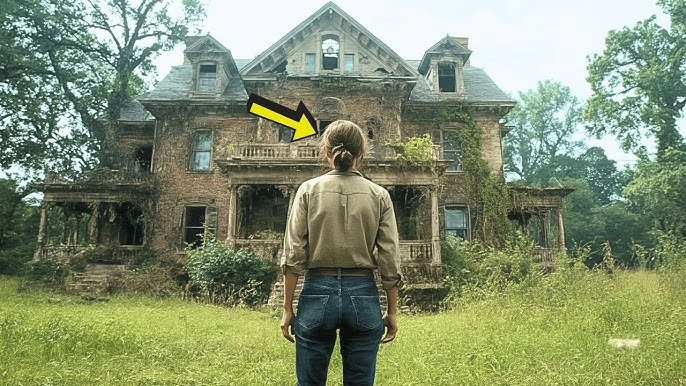When Olivia and Jack Monroe signed the papers for the Suffach farmhouse in spring 2023, they weren’t just buying a house — they were buying history. The weathered 400-year-old property, nicknamed Moat House by locals, had stood since before Napoleon, before railways, even before the United States existed.
It had 13 rooms, sagging beams, crooked floors, and a backyard that looked more like a forgotten woodland. To the Monroes, it was perfect. They wanted a challenge to share with followers on their social media renovation account. But within weeks, that “challenge” turned into something far beyond tiles and paint.
A Pattern in the Weeds
The backyard was the last priority. Plumbing, roof, kitchen — those came first. But one breezy April afternoon, Olivia noticed something odd beneath a mat of weeds: a neat circular brick formation.
“Jack, I swear this brick pattern wasn’t here last week,” she called.
At first glance, it looked like a flower bed ring. But the circle was too precise, the mortar too deliberate. Jack fetched a spade. Olivia started filming. What they unearthed was a perfect six-foot ring, its center covered by rotting wooden boards. When Jack tapped, the sound echoed hollow.
“Is this… a well?” Olivia whispered.
The Hollow Below
They measured with rope and a weighted camera. The shaft plunged 21 metres straight down — no water, just stone lining. Olivia uploaded the footage. Overnight, it went viral. Comments exploded:
- Cold storage shaft.
- Escape tunnel.
- Wartime hideaway.
But one comment froze her blood:
“Old Suffach houses sometimes hid stash wells. Check your land records.”
Whispers of the Past
Olivia contacted the Suffach Historical Preservation Society. Within a day, a reply arrived from Alan Kirkwood, a retired archivist. His email contained maps and one haunting name: Thomas Waywright, the estate’s 18th-century owner who vanished in 1797 amid rumors of treasure, madness, and a missing will.
The map Alan sent showed an outbuilding exactly where the well stood today. The past was aligning with their backyard.
The Dog Wouldn’t Go Near It
While builders reinforced the well with steel grates, things turned strange. Their dog, once playful in the garden, began growling at the shaft, refusing to go near. Outdoor lights flickered. Power tripped — but only on the side of the house facing the well.
A contractor friend inspected the bricks.
“These aren’t uniform. Some are older, some newer. Looks like someone sealed this deliberately.”
The Second Discovery
Jack followed his instincts to the treeline. Twelve feet from the well, his spade struck more bricks. This time, an oval arc appeared, ten feet long. Beneath it: a wooden hatch with iron brackets.
Olivia touched it and whispered, “This doesn’t feel like a well. It feels like a vault.”
Allan Arrives with the Records
Alan drove down the next day, carrying records dated 1795. One scrawl in the margin read: “Divided to protect. Let no one man claim it all.”
Waywright, paranoid and feuding with local authorities, had written of “a vault the war cannot take.” The hatch matched his descriptions.
But before they could open it, an anonymous envelope arrived — a copy of their land deed with a red circle over the backyard. Someone else knew.
The Journal in the Wall
Jack searched the untouched master bedroom. Behind a panel, he found a leather-bound journal signed by Thomas Waywright himself. Its entries veered between farming notes and paranoia:
“They come in the night.
The vicer lies.
The well is theirs to chase.
The vault is mine to guard.”
One page carried a hand-drawn map identical to the hatch’s location.
Opening the Hatch
At dawn, they pried open the lid. Inside, a stone chamber held:
- A rusted iron lockbox.
- A wax-sealed parchment map.
- A pouch of silver coins and rings.
- And a scroll marked: “To the future keeper of this land.”
The scroll’s words were chilling:
“What I leave is not treasure but proof.
This land was never to be sold.
Let my truth guard those who live here after me.”
The Will Beneath the Earth
Inside the lockbox lay documents and Waywright’s original will — transferring the estate and fields to tenant families. Modern deeds had ignored it. The hidden will could challenge 200 years of property ownership.
Suddenly, the Monroes realized: they hadn’t just found treasure. They’d found a time bomb of legal history.
Viral Sensation, Real Consequences
Olivia’s TikTok of the hatch hit millions of views. Reporters camped outside. Drones buzzed overhead. Anonymous letters warned them to stay quiet.
But with Alan’s guidance, they turned the documents over to solicitors. Experts confirmed the papers’ authenticity. A council review was scheduled.
From Mystery to Legacy
The Monroes chose not to sell, not to exploit, but to restore and preserve. The sealed chamber was fitted with a protective cover. The well became a community wishing well lit softly at night.
Olivia’s blog series, The Hidden Vault, drew readers worldwide. Jack’s quiet speech at a heritage event summed it up:
“It wasn’t about money. It was about truth. A man buried his story. We just happened to find it.”
Epilogue: The House That Remembers
Two months later, five rooms were restored. The lavender garden bloomed around the well. Local children dropped coins through the grate. The chamber became a small exhibition: Thomas Waywright — The Will Beneath the Earth.
One evening, as dusk fell, Olivia whispered, “Would you have believed this a year ago?”
Jack smiled, arm around her. “Not a chance.”
And in the stillness, the old farmhouse seemed to breathe easier, its secrets finally told.




